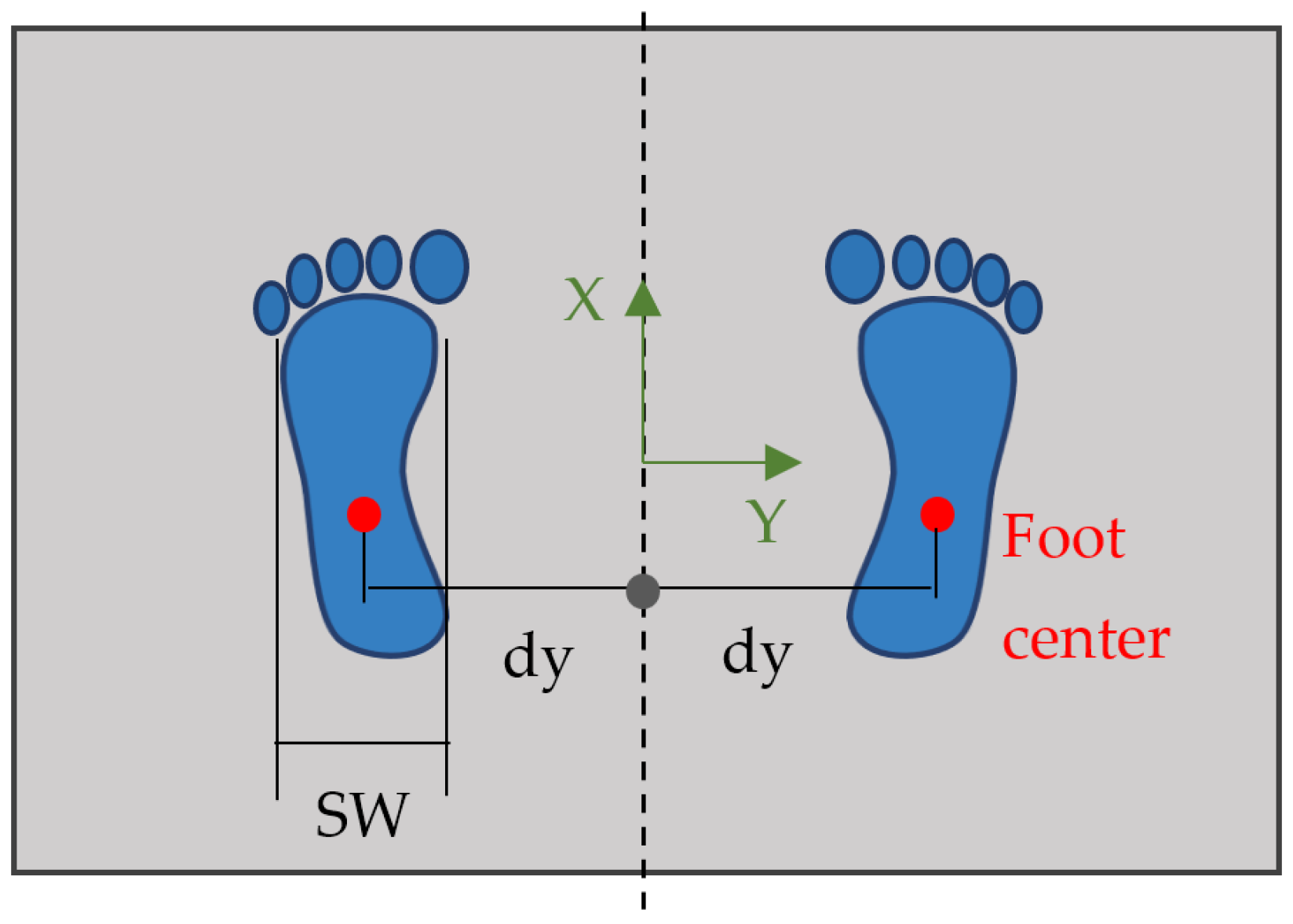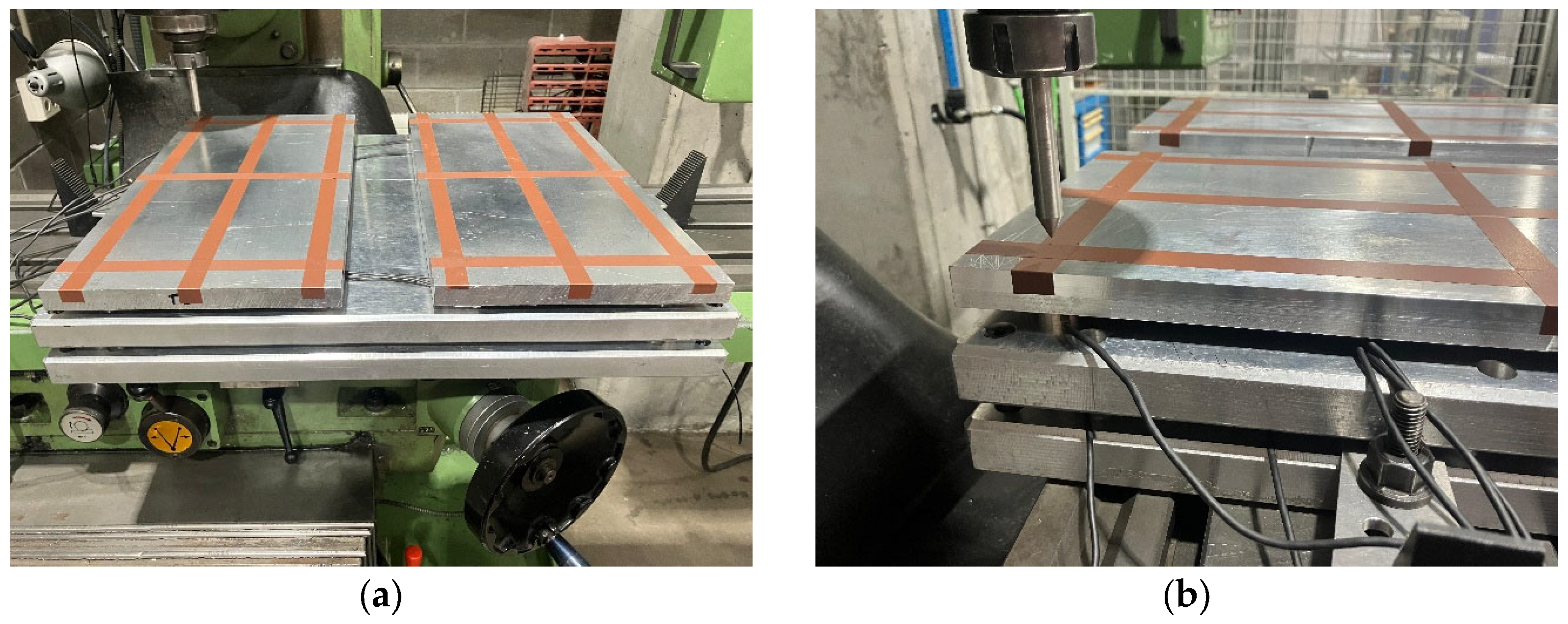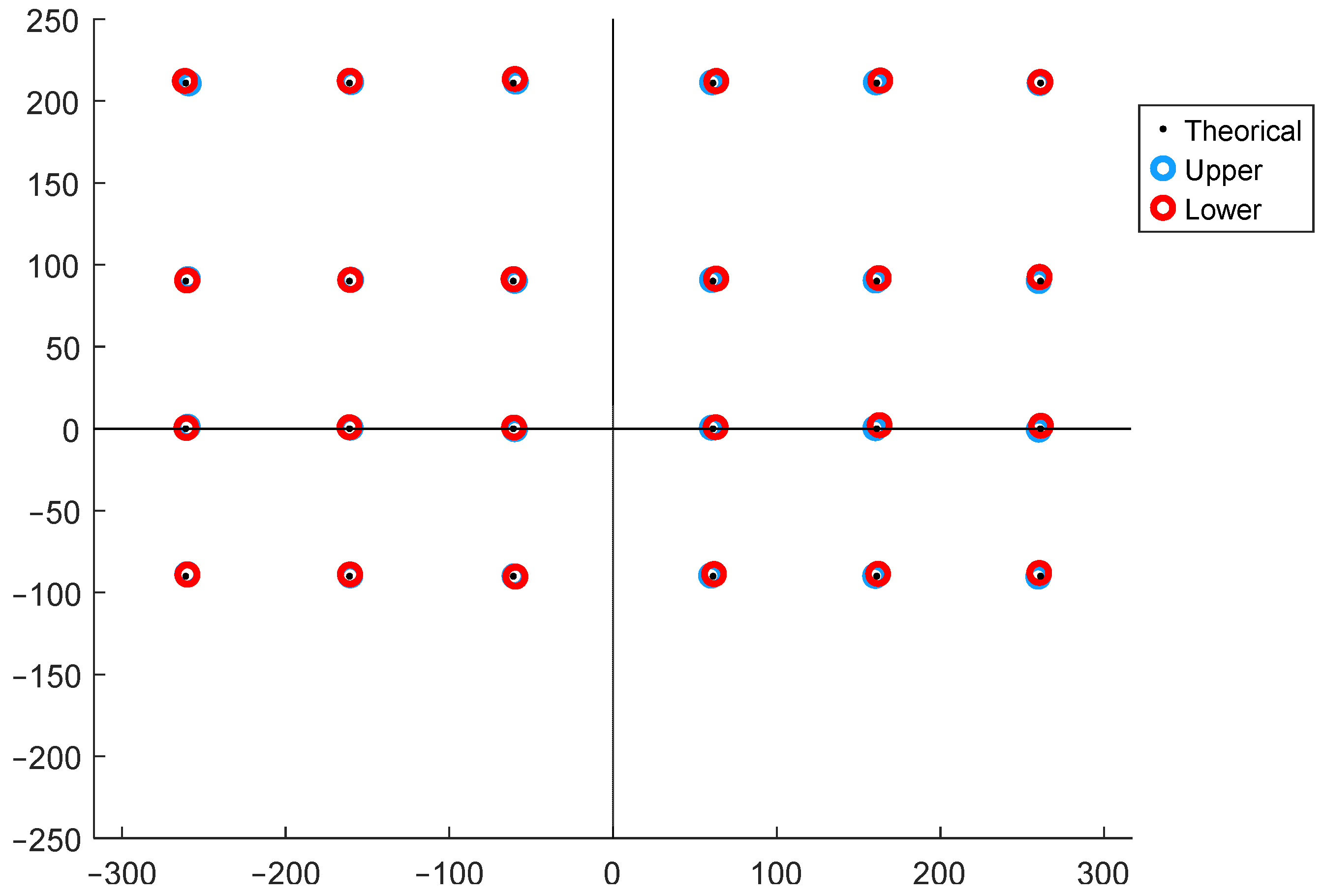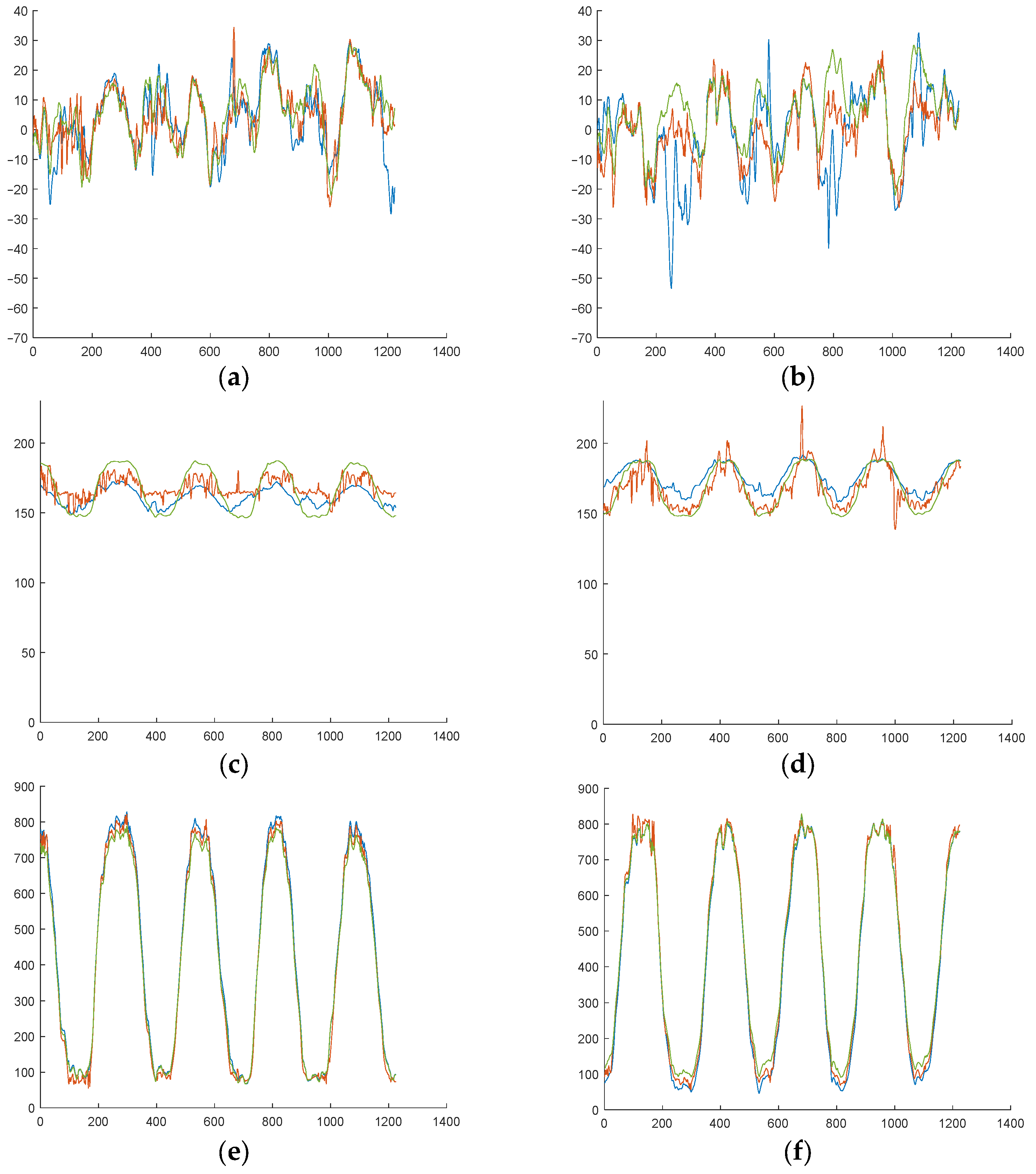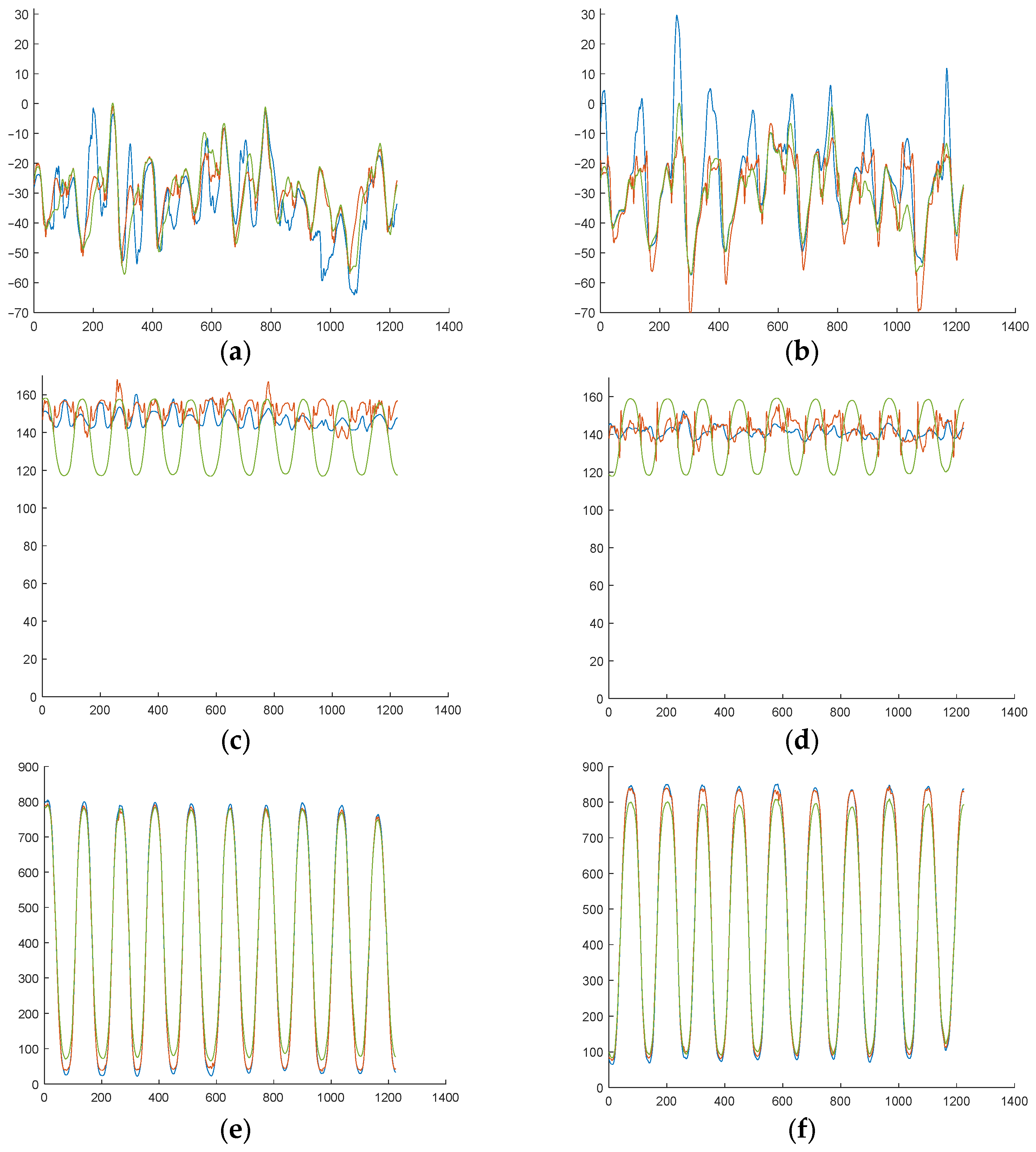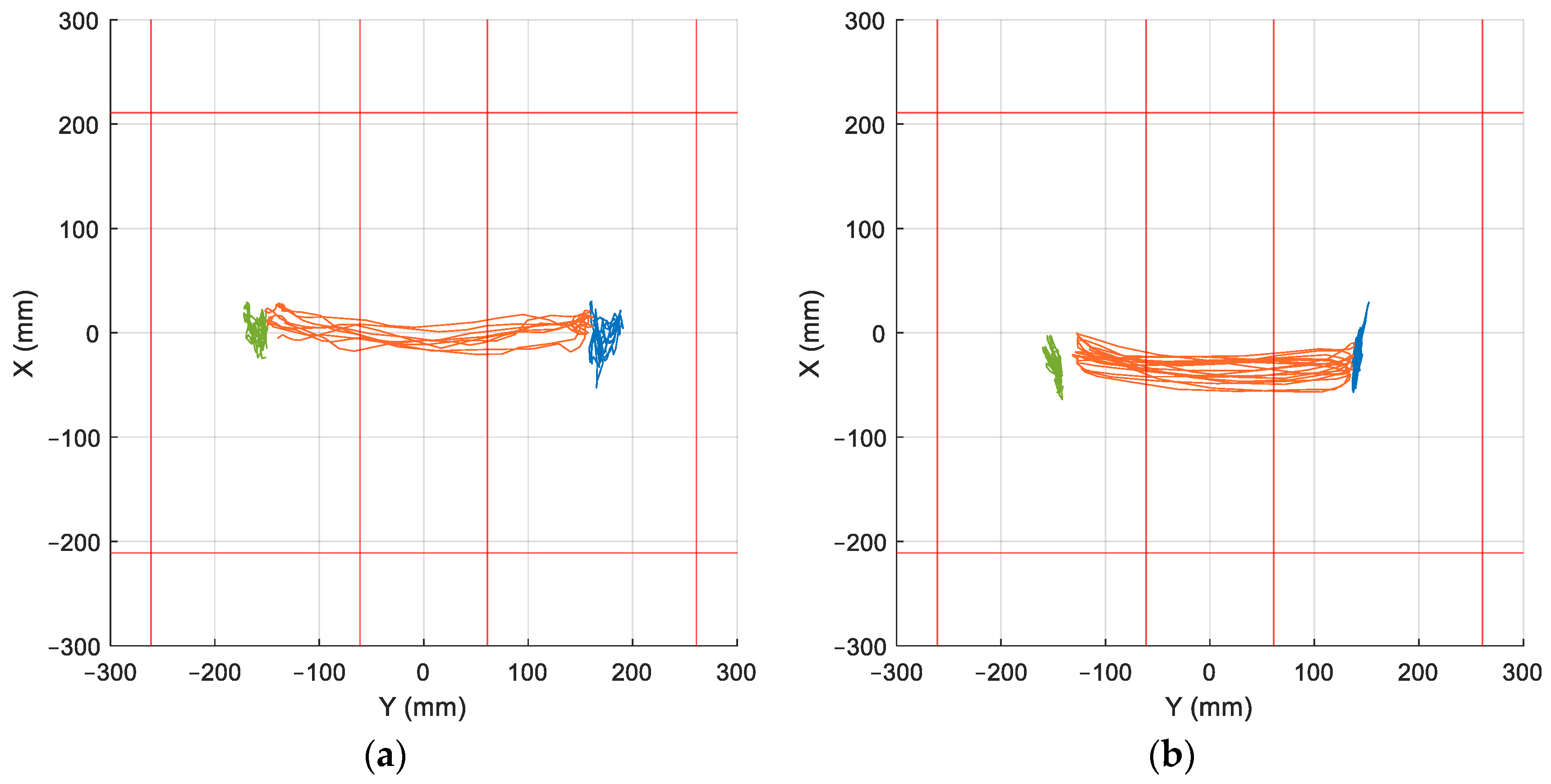2.2.1. Description and Validation
To validate this analytical hypothesis, a double forceplate device has been developed that allows the simultaneous measurement of each individual foot’s CoP and ground reaction forces applied and the global CoP and reaction force. This methodology enables the comparison of the global CoP behavior with the individual CoP behavior of each foot during a test. The device comprises two forceplates: a single forceplate placed underneath and a dual forceplate located on top of the first one, as illustrated in
Figure 2 and
Figure 3.
The device architecture and hardware consist of an aluminum plate at the base, measuring 600 mm × 500 mm × 35 mm, containing four uniaxial INELTA sensors, model IMK-DMS-2410-2m-K, with a DMS-sensitivity of 1 ± 10% mV/V and a cut-off frequency of 1000 Hz, as well as two aluminum plates at the top, measuring 240 mm × 500 mm × 20 mm, one for each foot, each containing the same four sensors as the plate below. The signals are collected by a National Instruments compact DAQ model 9188, using NI 9239 analog cards (Emerson Electric Co., St. Louis, MO, USA), and processed through a computer with an Intel Core i5-8250U processor (Intel Technologies, Santa Clara, CA, USA) with 8 GB of RAM memory. MATLAB R2024b software is used with the data acquisition toolbox installed.
The sensors employed are uniaxial, meaning that only vertical reaction forces can be measured, and horizontal components must be assumed to be negligible. The plane where the GRF is applied is not the same plane where the sensors measure the reactions, resulting in a potential error in the CoP calculation when the applied force has a horizontal component. This error was estimated in
Appendix A and was found to be negligible, since it does not exceed 1.7 mm.
The sensors of the upper forceplates are in close proximity to the corners of each plate; their locations can be seen in
Figure 4. The right plate sensors are located in symmetrical positions with respect to the Y-axis. In an analogous way, the sensors of the lower forceplate are located near the corners of the plate, directly below the four sensors at the outer corners of the two upper plates.
To verify the accuracy and ensure the consistency of the results obtained with both plates, the device was placed on a milling machine worktable equipped with a special tool to apply force mounted to the chuck (
Figure 5), allowing loads to be applied at precise locations with an error margin of ±0.01 mm. With this setup, a load between 200 N and 1000 N was applied at twelve different points on each of the two upper plates (see
Figure 6), enabling the assessment of the error produced by each forceplate.
The tare process is not possible with the hardware employed; consequently, it is performed during signal processing. To ensure the accuracy of the tare, a protocol was followed in each test. Firstly, the device’s data are recorded for at least three seconds without applying any load. Then, the load is applied for another ten seconds. In this manner, the mean of the initial seconds of the recorded signal is subtracted, which results in the taring of the measurements. Subsequently, the data from these initial seconds until the load is applied are removed, leaving an almost constant signal from which the average location of the load on each plate is calculated.
The data were processed using a zero-phase Butterworth filter with a cut-off frequency located at 10 Hz. Given that the displacement of the CoP during the test of human body balance reacts to frequencies ranging between 0.5 and 1 Hz, the cut-off frequency is adequate to ensure noise suppression without losing any relevant information from the sensors [
28].
The outcomes of the experimental tests are presented in
Figure 7, where the CoP location measured by the upper plate, the lower plate, and the actual points of application of the loads are shown in an overlay representation. The magnitude of the error committed is detailed in
Table 1, where it is demonstrated that the mean error incurred by the left upper forceplate is 1.255 ± 0.42 mm, that incurred by the right upper forceplate is 0.934 ± 0.26 mm, and that incurred by the lower forceplate is 1.631 ± 0.69 mm, with a maximum value of 2.764 mm, which is marginally higher than the error incurred by the upper plates. This outcome proves the reliability and precision of the device developed.
2.2.2. Experimental Protocol and Data Analysis
Once the device was validated, a series of tests were performed to assess the accuracy of the analytical hypothesis set out in
Section 2.1. For this purpose, a group of ten healthy subjects—between 24 and 47 years old, 9 male and 1 female, with a weight of 76.76 ± 14.07 kg—performed a series of exercises described in
Table 2.
These exercises have been designed to approximately reproduce the exercises that patients will perform on the OREKA machine platform (1, 2, and 3), as well as two control exercises (4 and 5) with the purpose of studying the most unfavorable cases for the analytical hypothesis in order to provide a solid framework for verification of the results obtained. Each test subject must repeat each test five times in order to obtain the relevant statistical data. In these exercises, the subject must perform displacements of their center of mass, which is a concentrated expression of the overall weight, while the CoP is the point where the plantar ground reaction force is applied, being displaced to keep the center of mass within the base of support [
29].
To ensure repeatability and to maintain a valid CoP reference frame, users should always place their feet in the same position, at a width equal to twice the distance
dy, and with their ankles aligned with the X-axis, as shown in
Figure 1. The arms should hang naturally to the sides and should always hold an upright posture.
As long as the feet never slip or lift off the platform, which is a prerequisite for the reliable application of the analytical hypothesis, any necessary body movements can be performed during the exercise. It is also recommended that no sudden movements are made in order to minimize, as much as possible, the effects of inertial forces that could increase the measurement error.
Test data were collected and later processed using protocols similar to those described in
Section 2.2.1 for the validation of the device, starting with the recording of a few seconds without any load to perform the tare. The user is then positioned and performs a squat before performing the exercise so that the starting time can be easily identified, ending with the recording of approximately 30 s of exercise movement. The data are processed by applying the Butterworth filter and then removing the time before the squat trigger of the acquisition in order to only keep the measured exercise data.
Once the test data are collected, they are treated by discarding the initial seconds of the acquisition, which are used to tare the measurement, and applying a low-pass filter at 10 Hz, as described in the previous section.
In order to verify the operation of the device under a real exercise condition, it is first assessed whether the global CoP measured by the lower plate matches that obtained from the measures by the upper plates during the tests according to expression (7).
To assess the performance of the equations, three indicators are used: the root mean square error (RMSE) (8), which is an overall error magnitude; the normalized RMSE (NRMSE) (9), which evaluates the relative error with respect to the actual range of variation and is a more representative indicator of the system’s accuracy; and the Pearson correlation coefficient (10), which determines the linear correlation between two sets data:
where
refers to the real measured signal values,
refers to the predicted signal values,
is the number of time steps, and
is the mean value of the signal for a specific test.
is a reference of the maximum value of the variable for each test subject: the foot length for the xCoP, the foot width for the yCoP, and the weight for the Fz.
As can be seen in
Table 3, the mean values of the RMSE between the upper and lower plates measurements are 0.655 ± 0.22 mm for the xCoP, 0.898 ± 0.49 mm for the yCoP, and 1.72 ± 0.5 N for the vertical reaction force.
From this point onwards, all tables and figures express RMSE and CoP measurements in millimeters (mm), force measurements in Newtons (N), NRMSE in percentage (%), and the COR coefficient as a dimensionless value ranging between −1 and 1.
To normalize the error, the xCoP data are divided by each subject’s foot length; the yCoP data are divided by the foot width (ball width), measured as described in [
30]; and the vertical reaction forces are divided by the subject’s weight, providing the NRMSE.
The results presented in
Table 4 indicate that the relative error of the xCoP is less than 0.4% in any case, as for the Fz measurement, which represents a very accurate result. In the case of yCoP displacement, the error is slightly higher but remains below 4%, which again confirms the high accuracy of the device verified in
Section 2.2.1., even in cases where moving loads are applied simultaneously to both upper plates.
In all instances, the correlation coefficient shown in
Table 5 for all variables exceeds 0.98, with the exception of the vertical reaction force in the ML test, where it drops to 0.927, a result that remains highly accurate, again demonstrating the satisfactory performance of the device.
After evaluating the correct operation of the device, as can be seen in
Figure 8, the accuracy of the analytical expressions proposed for each variable was assessed according to the three previously mentioned indicators in each type of test exercise.
As shown in
Table 6,
Table 7 and
Table 8, both the NRMSE and the correlation are better when calculating the xCoP than the yCoP, except in the rotation exercises, where the error in the xCoP increases significantly. This exception is consistent with the nature of the analytical model’s hypothesis, which assumes that the displacement of the CoP in the AP direction of both feet must be equal to the displacement of the global CoP; in the rotation exercise, where the sum of the displacements of both feet must result in a displacement that is nearly zero, the model is incapable of predicting the actual displacement of each foot separately.
In the remaining exercises, the outcome is consistent, as the physiognomy of the feet, which are approximately 2.5 times longer than they are wide, means that minor errors in the mediolateral direction have a proportionally greater effect than those made in the anteroposterior direction. Furthermore, due to the anatomical characteristics of the human body, maintaining equilibrium in the ML direction is more challenging [
31], so the yCoP exhibits more erratic and harder-to-model movements, which is reflected in the low correlation between the measured yCoP signal of each foot and the signal predicted from the global yCoP.
In consideration of the findings of [
32], it is evident that accurate measurement of the GRFs is crucial in the construction of biomechanical models, since small variations in the torque generated at the ankle can lead to large deviations in the torque generated at the knee and hip. Therefore, although the model may be valid for use in simple exercises, the error is too large to be applied to a general case.
For the exercises programmed on the OREKA machine (STC, AP, and ML), the NRMSE of the yCoP exceeds 6%, with a poor correlation coefficient. In contrast, the xCoP demonstrates a substantially reduced error rate, although the correlation is unsatisfactory except for the AP exercise, where a value greater than 0.9 is obtained, which is regarded as an acceptable value. The Fz of each foot has the lowest NRSME, under 2%, and the highest correlation for these exercises. This is of particular significance given that the value of this variable is critical for the correct calculation of the GRF.
Considering the results obtained, it can be concluded that, although the analytical hypothesis can adequately model the distribution of vertical GRFs between the two feet, it does not have the same level of accuracy in modeling the local CoP displacement, especially for exercises that do not fully meet the hypothesis assumptions (ROT and RND). As a result, the hypothesis is only acceptable for determining the Fz and the xCoP in AP exercises.

